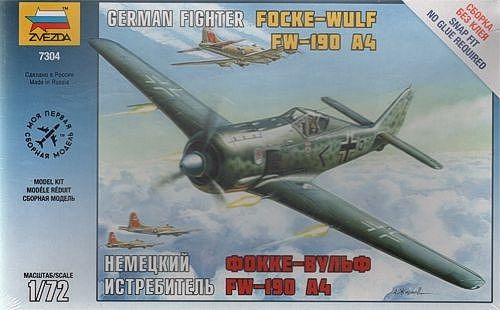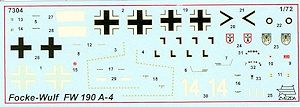
Zvezda 1/72 FW-190A-4
| KIT #: | 7304 |
| PRICE: | $12.00 SRP |
| DECALS: | Two options |
| REVIEWER: | Scott Van Aken |
| NOTES: | Snap kit |

| HISTORY |
Introduced in July 1942, the Fw 190 A-4 was equipped with the same engine and basic armament as the A-3. Updated radio gear, the FuG 16Z, was installed replacing the earlier FuG VIIa. A new, short "stub" vertical aerial mount was fitted to the top of the tailfin, a configuration which was kept through the rest of the production Fw 190s. In some instances, pilot-controllable engine cooling vents were fitted to the fuselage sides in place of the plain slots. Some A-4s were outfitted with a special Rüstsatz field conversion kit, comprising the fitting of a pair of under-wing Werfer-Granate 21 (BR 21) rocket mortars, and were designated Fw 190 A-4/R6. However, the A-4's main improvement was the number of Umrüst-Bausätze factory-refit package enhanced versions.
The U1 was outfitted with an ETC 501 rack under the fuselage. All armament except for the MG 151 cannon was removed. The U3 was very similar to the U1, and later served as the Fw 190 F-1 assault fighter. Some U3s used for night operations had a landing light mounted in the leading edge of the left wing-root. The U4 was a reconnaissance fighter, with two Rb 12.4 cameras in the rear fuselage and an EK 16 or Robot II gun camera. The U4 was equipped with fuselage-mounted 7.92 mm (.312 in) MG 17s and 20 mm MG 151 cannon. The U7 was a high-altitude fighter, easily identified by the compressor air intakes on either side of the cowling. Adolf Galland flew a U7 in the spring of 1943.
The A-4/U8 was the Jabo-Rei (Jagdbomber Reichweite, long-range fighter-bomber), adding a 300 L (80 US gal) drop tank under each wing, on VTr-Ju 87 racks with duralumin fairings produced by Weserflug, and a centreline bomb rack. The outer wing-mounted 20 mm MG FF/M cannon and the cowling-mounted 7.92 mm (.312 in) MG 17 were removed to save weight. The A-4/U8 served as the model for the Fw 190 G-1.
A new series of easier-to-install Rüstsatz field kits began to be produced in 1943. The first of these, the A-4/R1, was fitted with a FuG 16ZY radio set with a Morane "whip" aerial fitted under the port wing. These aircraft, called Leitjäger or Fighter Formation Leaders, could be tracked and directed from the ground via special R/T equipment called Y-Verfahren. More frequent use of this equipment was made from the A-5 onwards. The Fw 190A-4 could achieve 1,700 hp (2,100 with MW-50 boost). Its maximum speed was 416 mph (670 km/h) at 20,590 ft (6,250 m). Operational ceiling was 37,400 ft (11,400 m). Normal range was 497 miles (800 km). Normal takeoff weight was 8,378 lb (3,800 kg). A total of 976 A-4s were built between June 1942 and March 1943.
| THE KIT |
 For
those of you who might have built any of Zvezda's earlier 1/72 snap kit
aircraft, you know how really nice and well engineered these planes are. The
attachment points are quite large, making assembly, well, a snap. I said in an
earlier preview that the number of A-4 variant kits in this scale was small, but
I had not recalled this or an AZ Models kit.
For
those of you who might have built any of Zvezda's earlier 1/72 snap kit
aircraft, you know how really nice and well engineered these planes are. The
attachment points are quite large, making assembly, well, a snap. I said in an
earlier preview that the number of A-4 variant kits in this scale was small, but
I had not recalled this or an AZ Models kit.
The kit has a full cockpit tub and includes a pilot if one wishes to use it. Instrument panel has decals for instruments, which is standard in this scale. The cockpit is covered by a one-piece canopy. The head armor does not include a brace. Landing gear are well done and the kit can be built with the gear up if one wishes. The tail gear is molded with the right fuselage half. I did notice that the kit comes with later wheels. These may not be appropriate for the aircraft you are modeling so check references.
The instructions are well done and rather basic,
thanks in part to the minimal number of pieces with this one. Markings are
provided for two planes. One is the box art plane with IV/JG 1 in the fall of
1942. Both options are basically RLM 74/75/76 in the standard pattern. Both
planes have a lower cowling in yellow. The other
 option is
with IV/JG 2 based in Tunisia during the last months of that campaign. This one
has a while fuselage band, yellow rudder and a white stripe under each wing.
These stripes are provided as decals. The upper surface of this one is mottled
in either light grey or a green color depending on the background shade, making
for an interesting scheme. Decals are nicely done and do not include swastikas,
but do include full date markings and instrument panel decals.
option is
with IV/JG 2 based in Tunisia during the last months of that campaign. This one
has a while fuselage band, yellow rudder and a white stripe under each wing.
These stripes are provided as decals. The upper surface of this one is mottled
in either light grey or a green color depending on the background shade, making
for an interesting scheme. Decals are nicely done and do not include swastikas,
but do include full date markings and instrument panel decals.
| CONCLUSIONS |
Nice to see this being done. These kits are generally missing some items, like drop tanks or bomb racks, and will have a number of items molded in place, like the tail wheels, gun barrels and pitot tubes, which will take a bit more effort to keep intact. However, if you are seeking a fairly nicely detailed kit at a reasonable price, then you should seriously consider these as an alternative.
| REFERENCES |
http://en.wikipedia.org/wiki/Focke-Wulf_Fw_190
March 2014 Thanks to me for getting this one on sale.
If you would like your product reviewed fairly and fairly quickly, please contact the editor or see other details in the Note to Contributors.